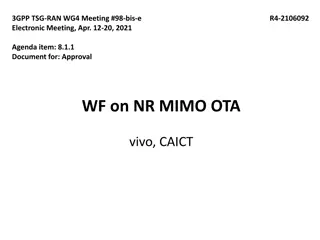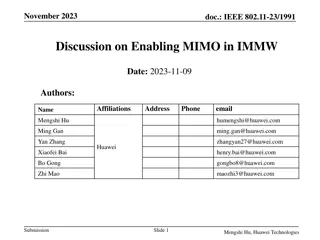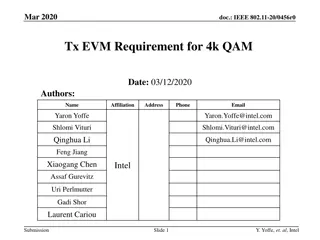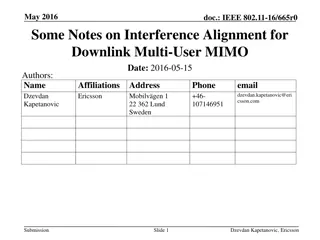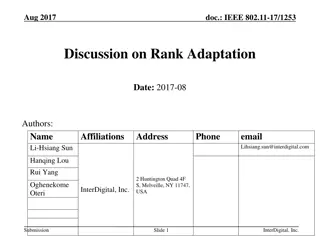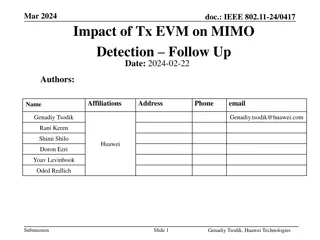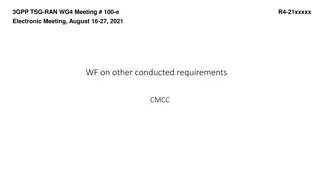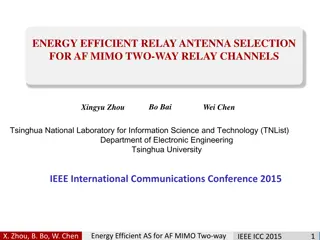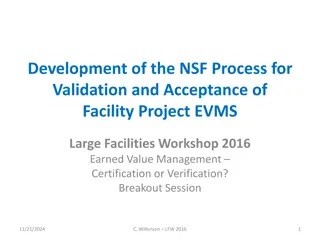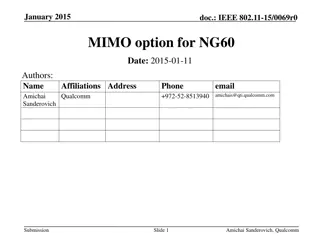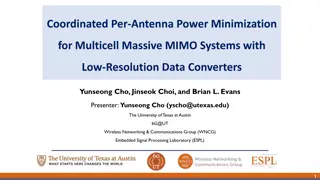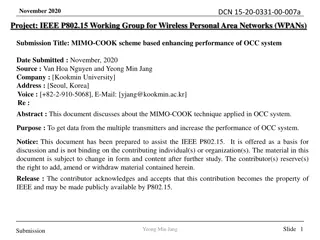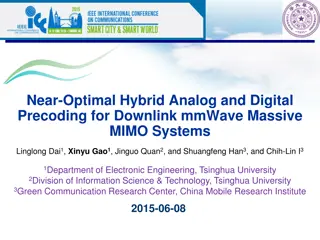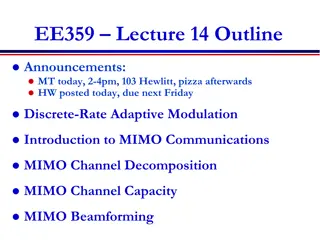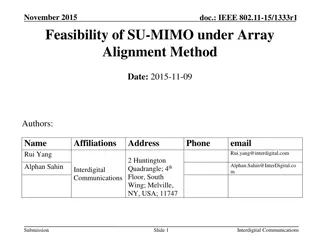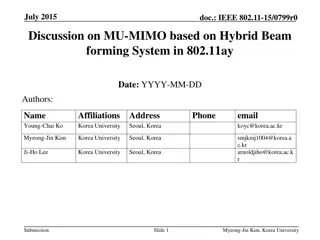
Impact of Tx EVM on MIMO Detection in Wireless Systems
Explore the impact of Transmit Error Vector Magnitude (Tx EVM) on MIMO detection in wireless systems, specifically focusing on the sensitivity of nonlinear detection methods to RF impairments and the challenges of setting transmit power accurately for MIMO transmission. Discover strategies to ensure optimal MIMO performance despite these obstacles.
Download Presentation

Please find below an Image/Link to download the presentation.
The content on the website is provided AS IS for your information and personal use only. It may not be sold, licensed, or shared on other websites without obtaining consent from the author. If you encounter any issues during the download, it is possible that the publisher has removed the file from their server.
You are allowed to download the files provided on this website for personal or commercial use, subject to the condition that they are used lawfully. All files are the property of their respective owners.
The content on the website is provided AS IS for your information and personal use only. It may not be sold, licensed, or shared on other websites without obtaining consent from the author.
E N D
Presentation Transcript
Nov 2023 doc.: IEEE 802.11-23/1944r0 Impact of Tx EVM on MIMO Detection Date: 2023-10-12 Authors: Affiliations Address Phone email Name Genadiy Tsodik Genadiy.tsodik@huawei.com Shimi Shilo Doron Ezri Huawei Yoav Levinbook Oded Redlich Submission Slide 1 Genadiy Tsodik, Huawei Technologies
Nov 2023 doc.: IEEE 802.11-23/1944r0 Background MIMO techniques are widely used in wireless systems (e.g. WLAN) to achieve higher spectral efficiency and increase the throughput In order to exploit the maximum gain of MIMO transmissions, nonlinear (near ML) detection is often applied at the receiver side, as it significantly outperforms linear detection However, in practice nonlinear detection is sensitive to RF impairments and requires a higher Tx EVM in order to achieve the desired performance Strong impairments may have a significant impact on the performance of nonlinear detectors, such that in some cases linear detection outperforms nonlinear detection We look into this issue in order to understand what may be done to ensure WLAN receivers can employ near ML detectors to yield a large performance gain (as expected from theory) Submission Slide 2 Genadiy Tsodik, Huawei Technologies
Nov 2023 doc.: IEEE 802.11-23/1944r0 Background Tx Power We assume that in most devices the max available power for high MCS values is set such that Tx EVM matches the standard requirement (or close to it) for single-stream Tx in an AWGN channel However, the Tx EVM required for MIMO operation is usually higher than that required for single stream transmission (due to sensitivity of the non-linear components) Devices can indicate the power headroom, but the relationship with their Tx EVM isn t clear How should the transmit power be set accurately, in case of MIMO transmission, such that the nonlinear components are reduced? Submission Slide 3 Genadiy Tsodik, Huawei Technologies
Nov 2023 MIMO Performance with Standard Tx EVM doc.: IEEE 802.11-23/1944r0 We simulated the MIMO performance using the same Back-Off (BO) required to match the standard Tx EVM In order to account for the impact of a larger BO (for example lower Tx power) we use SNR+OBO instead of SNR to compare between the different BO values Simulation parameters are: The required BO is 7.4dB MU-MIMO 4x4, PA model RAPP2 Near ML: K-Best Detection As we can see in the figure on the right, at the BO value of 7.4dB, MMSE detection outperforms ML detection Submission Slide 4 Genadiy Tsodik, Huawei Technologies
Nov 2023 doc.: IEEE 802.11-23/1944r0 Theoretical Analysis of Tx EVM Impact First, we analyze and show the impact of Tx EVM on the performance: the Tx signal includes EVM and is modeled as = + s s w = + = + + The received MIMO signal reads y Hs n Hs Hw n This means that assuming the EVM is Gaussian, the optimal MLD includes a whitening stage with inverse Cholesky of the Covariance (regular MLD has no whitening) ? QAM?? ?? ?2?? + ?2? 1? ?? ?ML= argmin ) ( ) ( 1 2 ( ) * 2 * 1 2 2 At high EVM, when , we get = = s y Hs HH y Hs H y s argmin argmin ML M M QAM s QAM s So in case of high Tx EVM, the optimal MLD coincides with linear detection Submission Slide 5 Genadiy Tsodik, Huawei Technologies
Nov 2023 doc.: IEEE 802.11-23/1944r0 How can we improve the performance? The theory that explains the issue and shows why linear detection outperforms nonlinear detection actually provides a direction for the solution If we reduce the variance of the Tx EVM component below the noise level, i.e. ?2 ?2the optimal detection no longer coincides with linear detection 1 ?2? ??2 ? QAM?? ?? ?2?? + ?2? 1? ?? argmin ?ML= argmin ? QAM? In other words, when nonlinear detection is employed we would like the transmitter to transmit with a higher Tx EVM One possible way to achieve an improved Tx EVM is to increase the BO, i.e. to transmit with a power lower than the nominal maximum power for a given MCS This may solve the issue presented in the previous slides and allow the receiver to exploit the gain associated with nonlinear detection Submission Slide 6 Genadiy Tsodik, Huawei Technologies
Nov 2023 Simulation Results Comparison w. MMSE doc.: IEEE 802.11-23/1944r0 We simulated the same scenarios, where we use a larger BO, than that needed to meet standard Tx EVM requirements In particular we compared the results of nonlinear detection with those of MMSE We can see that the impact of OBO on PER in case of MMSE detection is very small (although increasing OBO may improve MMSE as well) But near-ML is impacted significantly We can see that near ML detection outperforms MMSE detection by 6dB (including consideration of the reduced power due to higher BO) Submission Slide 7 Genadiy Tsodik, Huawei Technologies
Nov 2023 doc.: IEEE 802.11-23/1944r0 Summary While in theory nonlinear MIMO detection is superior to linear detection, in practice it suffers from the impact of RF impairments An additional Tx EVM improvement of 1-2dB may result in PER gain of many dBs for a MIMO transmission (e.g. 6dB gain as shown on the previous slide) We may significantly improve performance, if we adjust the Tx EVM for the specific MIMO scheme and the detector type currently employed at the receiver Submission Slide 8 Genadiy Tsodik, Huawei Technologies


